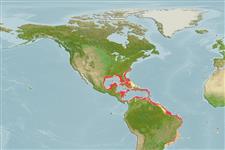>
Anguilliformes (Eels and morays) >
Muraenidae (Moray eels) > Muraeninae
Etymology: Gymnothorax: Greek, gymnos = naked + Greek, thorax, -akos = breast (Ref. 45335).
More on author: Cuvier.
Environment: milieu / climate zone / depth range / distribution range
экология
морской ассоциированный с рифами; пределы глубины 0 - 200 m (Ref. 9710), usually 0 - 35 m (Ref. 40849). Subtropical; 37°N - 26°S, 98°W - 5°W
Western Atlantic: North Carolina, USA and Bermuda to Brazil, including the Gulf of Mexico, the Caribbean to southeastern Brazil. Eastern Atlantic: Ascension and St. Helena (Ref. 4450). Mid- and eastern Atlantic islands (Ref. 26938).
Size / Вес / Возраст
Maturity: Lm ? range ? - ? cm
Max length : 200 cm TL самец/пол неопределен; (Ref. 57911); common length : 60.0 cm TL самец/пол неопределен; (Ref. 5217); наибольший вес (опубликованные данные): 2.5 kg (Ref. 40637)
Moderate-size moray with a pattern of distinct small, round, overlapping dark brownish to purplish-black spots on white or pale yellow background (Ref. 26938).
A benthic and solitary species (Ref. 26340) abundant in shallow rocky and grassy areas and on coral reefs; less common in turbid bays or harbors. Its bite is very dangerous (Ref. 5217). Active during the day, sometimes together with other predators. Feeds on fish and crustaceans (Ref. 42064). Usually seen with its head protruding from a hole and the rest of its body concealed (Ref. 26938). Observed to be unusually aggressive towards man (Ref. 86997). It has been traded as aquarium fish at Ceará, Brazil (Ref. 49392). Marketed fresh and salted (Ref. 5217).
Life cycle and mating behavior
половая зрелость | размножение | нерест | икра | Fecundity | личинки
Spawning migrations, leptocephalus larvae.
Robins, C.R. and G.C. Ray, 1986. A field guide to Atlantic coast fishes of North America. Houghton Mifflin Company, Boston, U.S.A. 354 p. (Ref. 7251)
Статус Красного Списка МСОП (Ref. 130435: Version 2024-1)
Угроза для людей
Traumatogenic (Ref. 5217)
Использование человеком
рыболовство: не имеет хозяйственного значения; аквариум: коммерческий
дополнительная информация
инструменты
Специальные отчеты
Скачать в формате XML
ресурсы в Интернет
Estimates based on models
Preferred temperature (Ref.
123201): 23.3 - 28, mean 26.5 °C (based on 630 cells).
Phylogenetic diversity index (Ref.
82804): PD
50 = 0.5000 [Uniqueness, from 0.5 = low to 2.0 = high].
Bayesian length-weight: a=0.00056 (0.00037 - 0.00085), b=3.27 (3.15 - 3.39), in cm total length, based on LWR estimates for this species & Genus-body shape (Ref.
93245).
Trophic level (Ref.
69278): 4.5 ±0.8 se; based on diet studies.
устойчивость к внешним воздействиям (Ref.
120179): низкий, минимальное время удвоения популяции 4.5-14 лет (Assuming tmax>10).
Fishing Vulnerability (Ref.
59153): Very high vulnerability (90 of 100).
Nutrients (Ref.
124155): Calcium = 10.1 [4.9, 20.1] mg/100g; Iron = 0.399 [0.211, 0.819] mg/100g; Protein = 19.5 [17.2, 22.0] %; Omega3 = 0.161 [0.064, 0.501] g/100g; Selenium = 32.8 [15.0, 68.8] μg/100g; VitaminA = 41.4 [10.9, 160.5] μg/100g; Zinc = 0.431 [0.281, 0.657] mg/100g (wet weight);
